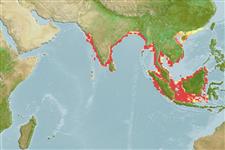Classification / Names
Common names from other countries
Main reference
Size / Weight / Age
Max length : 60.0 cm TL male/unsexed; (Ref. 12693); common length : 40.0 cm TL male/unsexed; (Ref. 4832); max. reported age: 2 years (Ref. 26929)
Length at first maturity
Lm 29.0 range ? - ? cm
Environment
Marine; freshwater; brackish; pelagic-neritic; anadromous (Ref. 51243); depth range 10 - ? m (Ref. 26929)
Climate / Range
Tropical, preferred 28°C (Ref. 107945); 23°N - 7°S, 70°E - 119°E (Ref. 54917)
Distribution
Indo-West Pacific: India to the Java Sea and the South China Sea. Newly recorded from Mauritius (Ref. 33390). May be found in Cambodian Mekong near the Viet Nam border (Ref. 12693).
Countries | FAO areas | Ecosystems | Occurrences | Introductions
Short description
Dorsal
spines
(total): 0;
Anal
spines: 0. Belly with 28 to 30 scutes. A distinct median notch in upper jaw, which distinguishes it from other similar clupeids, except Hilsa kelee. Gill rakers fine but not numerous, 60 to 100 on lower part of arch. Caudal fin short. At most, a dark diffuse mark behind gill opening, but no other spots on flank.
IUCN Red List Status (Ref. 115185)
Threat to humans
Harmless
Human uses
Fisheries: highly commercial
More information
ReferencesAquacultureAquaculture profileStrainsGeneticsAllele frequenciesHeritabilityDiseasesProcessingMass conversion
Tools
Special reports
Download XML
Internet sources
Estimates of some properties based on models
Phylogenetic diversity index
PD50 = 0.5312 many relatives (e.g. carps) 0.5 - 2.0 few relatives (e.g. lungfishes)
Trophic Level
2.5 ±0.00 se; Based on food items.
Resilience
High, minimum population doubling time less than 15 months (K=0.7; assuming tmax>3, fec > 10,000)
Vulnerability
Low to moderate vulnerability (27 of 100)
Price category
